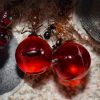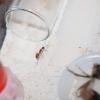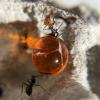I have a feeling of hope for these queens. I know this is not really the same thing but Camponotus pennsylvanicus have NEVER been recorded to be polygynous in any parts of the U.S. to my knowledge, yet I have a two-queen colony that's doing great. I have a feeling that anything can be possible at this point. If I can make a polygynous pennsylvanicus on accident, then what's not to say a multispecies of Myrmecocystus can't happen.
Many large-colony Camponotus and Messor species appear to have a natural tendency towards oligogyny (usually they adopt queens - often their own - in outskirt satellite nests), so with those it at least seems kinda plausible to have a multiqueen colony.
Very few North American species I've observed do that. In fact, I don't believe I've ever seen that happen in North American Camponotus at all and I've seen quite a few colonies of them now in my life. I could be wrong though. I haven't seen the Eastern and Southeastern U.S. Camponotus yet.
Edited by NicholasP, August 30 2022 - 7:08 AM.


















